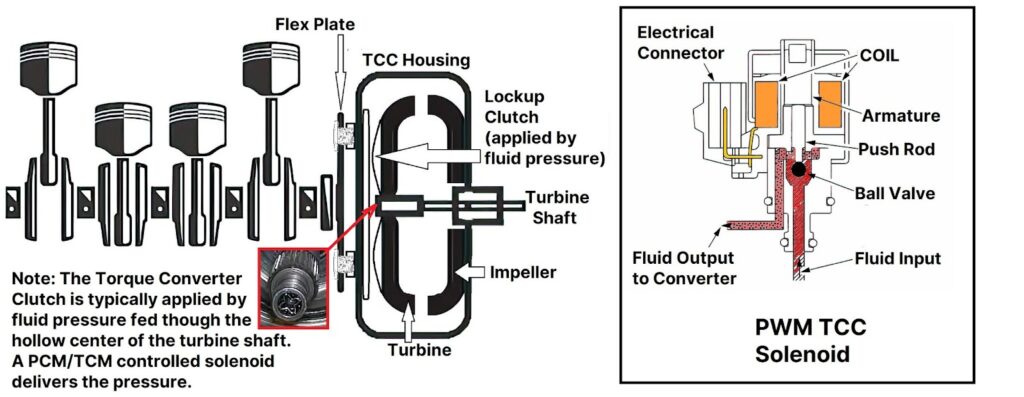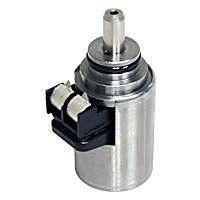Does your vehicle often stall when coming to a stop, exhibit shifting issues, and show signs of reduced fuel economy? Your torque converter clutch solenoid may be at fault. To confirm, run your OBD-II scanner. If it indicates a P0740 Code, use this guide to address the issue immediately.
What Does the P0740 Code Mean?
Diagnostic trouble code (DTC) P0740 stands for “Torque Converter Clutch Solenoid Circuit/Open Circuit Malfunction.” Take note that many vehicles don’t even list this as a possible code. But on vehicles that include P0740, it indicates that the control module (PCM or TCM – Transmission Control Module) perceives an electrical fault with the torque converter clutch solenoid or the solenoid’s circuit.

However, there are some vehicles for which the code is more indicative of a mechanical problem with the transmission or torque converter.
Note: Although code P0740 is a generic code specified by the Society of Automotive Engineers (SAE), the code’s definition may vary depending on the vehicle manufacturer.
For an in-depth, technical discussion of how P0740 is triggered, read the next section.
If you want to learn the possible causes of P0740, click here.
P0740 on Some Dodge Vehicles
Code P0740 may appear on some Dodge vehicles like the 2013 Dodge Grand Caravan SE 3.6L V6.
The torque converter clutch (TCC) is modulated by controlling the duty cycle of the L/R Solenoid until the difference between the Engine RPM and the Transmission Input Speed RPM or duty cycle is within a desired range. The DTC is set after the period of 10 seconds and three occurrences of either: FEMCC – with slip greater than 100 RPM or PEMCC – duty cycle greater than 85%.
For this specific vehicle, it is recommended to first perform a pre-diagnostic troubleshooting procedure before proceeding. It is also recommended to check if related DTCs are present using a scan tool.
How Code P0740 is Triggered
The torque converter is located between the rear of the engine and the front of the transmission. Inside this device is the torque converter clutch (TCC)—a component made up of a friction material that locks the converter shell onto the turbine shaft.
The clutch creates a mechanical connection between engine and transmission. Applying the TCC reduces engine RPMs, lowers the temperature of the transmission fluid, and increases fuel economy.
The control module uses inputs from various sensors to determine when it is appropriate to apply the torque converter clutch. Once the module deems conditions are correct, it commands one or more TCC solenoid valves to engage the TCC clutch.
On most vehicles, the module will set a P0740 code when it detects an electrical fault with the TCC solenoid or the TCC control circuit.
A 2006 Explorer, for example, defines the P0740 as “TCC circuit fails to provide voltage drop across solenoid. Circuit open or shorted or PCM driver failure during on-board diagnostics.”
A 2006 Explorer, for example, defines the P0740 as “TCC (torque converter clutch) circuit fails to provide voltage drop across solenoid. Circuit open or shorted or PCM driver failure during on-board diagnostics.”
–Richard McCuistian, ASE Certified Master Automobile Technician
It’s a simple matter for the ECM/TCM to measure the continuity of any solenoid on the controlled side of that coil. On a solenoid that is hard-wired to power, the ECM/TCM looks for 12 volts at the controlled side of the solenoid whenever the solenoid isn’t energized (grounded). On a solenoid that is hard wired to ground, that same strategy works, except that the ECM/TCM is looking for ground on the controlled side of the deenergized coil rather than power.
But as was mentioned earlier, on some vehicles, the P0740 code may set when the TCC’s performance is out of range due to a mechanical problem.
To search our database for other OBD2 codes, click here.
What are the Possible Causes of the P0740 Code?
A P0740 OBD-II code is a generic trouble code that is supported by many cars. But while this diagnostic code can appear on a variety of vehicles, the steps for diagnosis and repair may vary depending on the vehicle’s make and model.
Listed below are some of the common issues that can trigger a P0740 code:

- Defective transmission converter clutch solenoid
- Electrical fault inside the TCC solenoid circuit
- Internal transmission failure
- Low transmission fluid level
- Contaminated transmission fluid and/or clogged transmission filter
- Faulty sensor inhibiting proper TCC operation
- Problem with the control module, such as software in need of an update· Transmission valve body problems
Note: If there are other codes stored in addition to P0740, the causes and symptoms may differ from those listed here.
What are the Common Symptoms of the P0740 Code?
A P0740 code should always be addressed immediately to prevent further damage to the vehicle. It may be unsafe to drive if this trouble code is accompanied by drivability symptoms.
If you experience any of the signs below, make sure to address the issue right away.
Check Engine Light illuminates
A wide variety of problems can trigger the check engine warning light, including an issue with the TCC or related components.
Shifting problems
Your transmission may exhibit problems, such as slippage, harsh shifting, and a limited gear range.
Engine stalling
If the TCC is stuck on, it may cause the vehicle to stall when coming to a stop.
Shudder felt throughout the vehicle
A TCC that isn’t engaging/disengaging properly can cause a shudder that’s felt at certain speeds.
Reduced fuel economy
Failing to engage the torque converter clutch results in slippage that reduces fuel mileage.
Increase in engine speed
A TCC that isn’t engaging can cause a slight increase in engine RPMs.
How to Diagnose the P0740 Code
Diagnosing and testing your vehicle’s torque converter clutch system can be difficult. It’s best to have a professional troubleshoot the problem for you.
However, if you choose to do the job yourself, the following videos will give you an idea of what’s involved:
How to Fix the P0740 Code
Before diving into the repair procedure, it’s a good idea to check for possible technical service bulletins (TSBs) about your vehicle first and see if there are any announcements about the code you’re dealing with.
Technical service bulletins serve as announcements from the vehicle manufacturer about particular issues and how to resolve them.
These announcements are intended for dealership technicians, but many aftermarket companies and independent technicians republish these pieces of information for other auto shops and vehicle repair facilities.
You can also check TSBs about your vehicle online.
Websites from authorities like the National Highway Traffic Safety Administration (NHTSA) and Environmental Protection Agency (EPA) have search tools where you can enter your vehicle’s identification number (VIN), and find out whether or not there are TSBs about your daily driver.
In most cases, a vehicle that’s under warranty with a TSB-related issue can get repaired for free.
But if there aren’t any TSBs about your vehicle and the P0740 trouble code, here’s what you should do:
- First, check for resistance from the torque clutch converter solenoid. In some guides, this might be referred to as the variable force solenoid.
Then, unplug the gray (C1) connector at the powertrain control module.
The resistance between pins 73 and 26, 27, or 28 should approximately be five ohms.
- While performing the procedure, also verify that the correct type of transmission fluid is used. Depending on specifications, a vehicle might require a special type of transmission fluid.
Chrysler, for example, offers an ATF +4 transmission fluid for its models.
- The next step is to check the clutch volume index (CVI) on the scan tool to gather information about the clutch packs. Below are the normal ranges for CVI:
- Low-Reverse: 16-63
- 2-4: 16-54
- OD: 42-143
- UD: 26-74
- LC: 16-25
- DC: 26-34
A value outside of the normal range indicates a mechanical fault with the transmission.
Note: Certain terms that were mentioned in the procedure above might be different in other vehicles.
Keep in mind that it’s possible for the torque converter clutch solenoid to get stuck in the applied position once it gets too hot. This concept applies even when voltage is removed from the solenoid upon applying the brakes.
A faulty solenoid can also affect the torque converter clutch’s performance. Here’s what you can do to test it.
- First, drive the vehicle around until it reaches its normal operating temperature. Make sure that it’s driven on a flat-level road away from traffic.
- Maintain a constant speed then slowly apply the brakes to open the electrical circuit for the torque converter.
The torque clutch converter should disengage and the RPM should increase anywhere between 150 and 250 RPM and drop back once the brake pedal is released.
Should you have any trouble following the repair procedure, it’s best to simply bring your vehicle to the nearest auto repair shop and have a trained professional do the job. This will ensure that all steps for diagnosis and repair are followed correctly.
More About The Torque Converter Clutch
The torque converter clutch (TCC) is inside the converter itself and engages in 3rd and/or 4th gear to provide a gas mileage boost by providing a direct connection between the torque converter shell, which is bolted to the crankshaft flex plate, and the turbine, which drives the transmission input shaft. This connection is typically modulated by percentage of slip from zero to 100 percent. The solenoid “dithers” its way up to maximum lockup.

The TCC solenoid allows precise control of the torque converter clutch by the PCM or TCM. The TCC solenoid can be a duty cycle or a pulse-width modulating solenoid. The pulse-width Modulated solenoid used for this purpose is capable of operating at:
- Zero percent PWM (off): ball valve closed, zero pressure. Converter clutch completely released.
- 100 percent PWM: ball valve fully open, full pressure. Converter clutch completely applied.
- Between zero and 100 percent PWM: Allowing variable pressure for controlled clutch application.
The TCM/PCM is watching engine speed, input shaft speed, and output shaft speed as well as vehicle speed, throttle angle, engine coolant and transmission oil temperature, etc. to decide when to engage the converter clutch.
Where to Get a New Torque Converter Clutch Solenoid for Your Vehicle
If you’re experiencing any of the symptoms above and have confirmed that a faulty torque converter clutch solenoid is the culprit, don’t delay replacing it. Otherwise, it could affect other parts, resulting in more trouble codes and more expensive repairs. Luckily, you can find and order what you need at CarParts.com without any hassle.
As your one-stop shop for high-quality replacement parts, we take the guesswork out of finding solenoids that fit your ride and match your needs. Fill out the vehicle selector to view compatible parts, then adjust the filters based on your preferences. After placing your order, you can expect your new solenoid at your doorstep in just a few days.
On top of that, our torque converter clutch solenoids come at competitive prices, so you can shop without breaking the bank. Check out our catalog today.
Products Mentioned in this Guide
Any information provided on this Website is for informational purposes only and is not intended to replace consultation with a professional mechanic. The accuracy and timeliness of the information may change from the time of publication.


 Torque Converter Clutch Solenoid
Torque Converter Clutch Solenoid
 Torque Converter
Torque Converter















cost to fix a PO740 Torque Converter Clutch Circuit
Hi Richard,
The cost of the repair will depend on a variety of factors, including (but not limited to) the cause of the code and the type of vehicle you have.